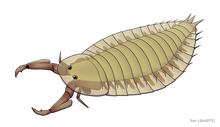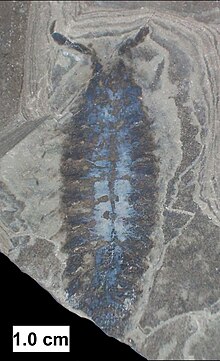Parioscorpio
| Parioscorpio | |
|---|---|

| |
| Reconstruction as a non-scorpion, enigmatic arthropod | |

| |
| Fossil specimen of Parioscorpio venator | |
| Scientific classification | |
| Domain: | Eukaryota |
| Kingdom: | Animalia |
| Phylum: | Arthropoda |
| Genus: | †Parioscorpio Wendruff et al, 2020 |
| Type species | |
| †Parioscorpio venator Wendruff et al, 2020
| |
Parioscorpio is an extinct genus of
Taxonomy
The fossils were originally discovered in 1985, tentatively identified as a
cheloniellids in a Ph.D dissertation,[9] but the name was never published in a peer-reviewed journal and is therefore not valid in accordance with the International Code of Zoological Nomenclature. Upon initial publication in 2020, Parioscorpio was considered the world's oldest and most primitive known scorpion, older than Dolichophonus from Scotland by several million years.[3] In 2021, the fossils were reanalysed, and Parioscorpio was found not to be a scorpion, but an arthropod of uncertain placement, outside of Mandibulata, Chelicerata and all other groups of extinct arthropods (e.g. Megacheira, Fuxianhuiida, Artiopoda and so on).[8]
In 2021 another paper stated that Parioscorpio venator, including the fossils previously called Latromirus, might be a
In 2022 a study was published describing euarthropod.[13]
Morphology

The animal is around 1.6–4.5 cm (0.63–1.77 in) long.tergite) and appendages.[8] The first segment is covered by the head while the posterior segments may have lateral spines.[8] The anterior 12 pairs of trunk appendages are multiramus (each composed of 4 bundles of setae and a segmented endopod) while the last two pairs are simple fan-like structures.[8] The trunk ends with 3 spines.[8]
Paleoecology
Parioscorpio may had been a marine or brackish water
References
- ^ S2CID 36327898.
- ^ S2CID 245285654.
- ^ PMID 31949185.
- ^ "This is the oldest scorpion known to science". www.science.org. Retrieved 2023-01-01.
- ^ Magazine, Smithsonian; Wu, Katherine J. "World's Oldest Scorpions May Have Moved From Sea to Land 437 Million Years Ago". Smithsonian Magazine. Retrieved 2023-01-01.
- ^ Lazaro, Enrico de (2020-01-20). "Fossils of Earliest Known Scorpion Discovered | Sci.News". Sci.News: Breaking Science News. Retrieved 2023-01-01.
- JSTOR 2396972.
- ^ S2CID 234812878.
- ^ Wendruff, Andrew J. (2016). Paleobiology and Taphonomy of exceptionally preserved organisms from the Brandon Bridge Formation (Silurian), Wisconsin, USA (PhD thesis). The Ohio State University.
- S2CID 85744103.
- ^ S2CID 249652930.
- ^ S2CID 252839113.
- ISSN 0266-6979.
- JSTOR 2396972.
